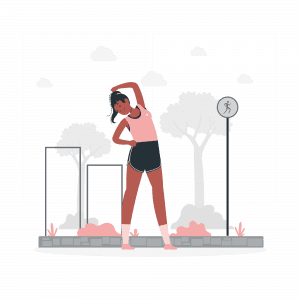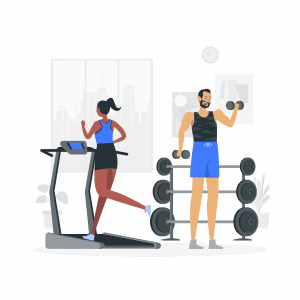Introduction
Are you ready to shake up your fitness routine? Physical challenges are not just fun; they’re a fantastic way to boost your health at any fitness level. The CDC puts it simply: regular physical activity is crucial for your health. It’s all about improving your brain health, managing weight, warding off diseases, strengthening bones and muscles, and enhancing your daily functionality. In this blog, we’re diving into 10 exciting physical challenges tailored for everyone, whether you’re taking your first fitness steps or you’re a seasoned gym enthusiast. Each challenge is crafted to add a burst of energy and enjoyment to your fitness journey, helping you unlock the full spectrum of benefits that come with staying active.
Beginner Bodyweight Challenges as Physical Challenges

Embarking on your fitness journey with physical challenges that cater to beginners is a great way to build foundational strength. The Beginner Bodyweight Challenge is a perfect example of a physical challenge designed for those new to exercise or for anyone looking for a no-equipment workout. It focuses on form and consistency, crucial elements for long-term fitness success.
Squats:
This fundamental exercise in the physical challenge targets your lower body. Stand with feet shoulder-width apart, lower into a squat position keeping your back straight, then rise back up. Aim for 3 sets of 10-15 repetitions.
Lunges:
An essential part of this physical challenge, lunges work on your legs and glutes. Step forward into a lunge, ensuring your knee doesn’t go over your toe, then push back to standing. Alternate legs for 3 sets of 10 repetitions each.
Push-Ups:
A core exercise in any physical challenge, push-ups target your upper body. Start in a plank position and lower your body, keeping elbows close to your body. Beginners can modify by keeping their knees on the floor. Aim for 3 sets of 5-10 repetitions.
Plank:
Planks are a great way to build core strength in this physical challenge. Hold a plank position for 20-30 seconds, keeping your body in a straight line and engaging your core.
Glute Bridge:
To complete this beginner’s physical challenge, the glute bridge is an effective exercise. Lie on your back, lift your hips, and hold for a few seconds before lowering. Perform 3 sets of 10-15 repetitions.
This beginner bodyweight physical challenge is designed to be accessible yet challenging, helping you to build strength and endurance gradually. It’s a great way to start your journey into more complex physical challenges, setting a solid foundation for your fitness journey.
Also Read: Work From Home Exercises
Intermediate Running or Jogging Challenges as Physical Challenges

For those at an intermediate level in their fitness journey, a running or jogging challenge can be an exhilarating physical challenge to elevate endurance and cardiovascular health. This challenge involves a progressive plan that gradually increases in distance or intensity, catering to those who are already comfortable with basic running or jogging.
Baseline Assessment:
Start by assessing your current running capability. How far can you comfortably run without stopping? Use this as your baseline.
Weekly Incremental Increases:
Each week, increase your running distance by about 10%. If you’re running 2 miles comfortably, aim for 2.2 miles the following week, and so on. This gradual increase helps improve endurance without overexertion.
Incorporate Interval Training:
Once a week, replace a regular run with interval training. This involves short bursts of high-intensity running followed by a period of lower intensity or walking. For instance, run at high intensity for 1 minute followed by 2 minutes of walking or light jogging. Repeat for 20-30 minutes.
Long Run Day:
Dedicate one day a week to a long, slower-paced run. This builds endurance and teaches your body to burn fat as fuel.
Rest and Recovery:
Ensure you have adequate rest days to allow your body to recover. This is crucial in any physical challenge to prevent injury.
Cross-Training:
Incorporate activities like cycling or swimming into your routine. Cross-training can improve overall fitness and reduce the risk of injury from repetitive strain.
Track Progress:
Keep a journal or use a fitness app to track your progress. This can be motivating and help you adjust your plan as needed.
This intermediate running or jogging physical challenge is designed to push your limits gradually and sustainably. It’s an excellent way to challenge your cardiovascular system, improve stamina, and achieve new fitness milestones. Remember, listen to your body and adjust the intensity to match your individual fitness level and goals.
Advanced HIIT Challenges as Physical Challenges

For those looking to take their fitness to the next level, an Advanced HIIT (High-Intensity Interval Training) Challenge offers an intense physical challenge that combines high-energy exercises with short rest periods. This type of training is ideal for advanced fitness enthusiasts seeking to improve their strength, endurance, and cardiovascular health.
Challenge Structure:
Plan for a 4-week HIIT challenge, with workouts scheduled 3-4 times per week. Each session should last about 20-30 minutes, consisting of high-intensity exercises followed by brief rest periods.
Dynamic Warm-Up:
Begin each session with a 5-minute dynamic warm-up to prepare your body. Include exercises like jumping jacks, high knees, and dynamic stretching.
Circuit Design:
Create a circuit of exercises to be performed back-to-back. Each exercise should be done at maximum intensity for 40-50 seconds, followed by a 10-20 second rest period before moving to the next exercise.
Exercise Selection:
Include a variety of exercises targeting different muscle groups. Examples include burpees, jump squats, mountain climbers, push-ups, plank jacks, and high-intensity lunges.
Intensity and Progression:
Ensure the exercises are challenging enough to push your limits. Each week, increase the intensity by adding more repetitions, extending the work period, or reducing the rest time.
Cool Down and Recovery:
Conclude each session with a cool-down period consisting of light jogging or walking and static stretching. This aids in recovery and reduces the risk of injury.
Hydration and Nutrition:
Pay attention to your hydration and nutrition. HIIT is demanding, and your body will need adequate fuel and recovery.
Safety First:
Given the intensity, it’s crucial to listen to your body. Ensure you’re performing exercises with correct form to avoid injury.
This Advanced HIIT physical challenge is designed to push your physical boundaries and offer a rigorous test to your fitness levels. It’s a great way to experience high-intensity training, leading to significant improvements in metabolic rate, muscular endurance, and overall fitness.
Read Further: Wellness Activities for Adults
Yoga Flexibility Challenges as Physical Challenges

A Yoga Flexibility Challenge serves as an excellent physical challenge for individuals at all fitness levels, focusing on improving flexibility, balance, and overall well-being. This challenge is a gentle yet effective way to enhance body awareness and mindfulness through various yoga poses and stretches.
Challenge Duration and Frequency:
Set a 30-day challenge with daily yoga practice. Each session can range from 15 to 30 minutes, depending on your schedule and level of experience.
Yoga Poses Selection:
Incorporate a variety of yoga poses that target different areas of the body. Beginners can start with basic poses, while more experienced practitioners can opt for advanced variations. Include poses like:
-
-
- Cat-Cow Stretch for spinal flexibility.
- Downward-Facing Dog to stretch the hamstrings and calves.
- Warrior poses for leg strength and balance.
- Child’s Pose for relaxation and lower back stretch.
- Pigeon Pose for hip flexibility.
- Cobra or Upward-Facing Dog for spine flexibility and strengthening the back.
-
Focus on Breathing:
Emphasize the importance of deep, controlled breathing throughout the practice. Breathing helps deepen the stretches and promotes relaxation.
Progress Tracking:
Encourage participants to track their progress, noting improvements in flexibility and any changes in how they feel physically and mentally.
Restorative Yoga Once a Week:
Include a restorative yoga session once a week to deeply relax the body and mind. This can include poses held for longer periods with the support of yoga props like bolsters and blocks.
Guided Practice Option:
For those new to yoga, recommend following guided yoga sessions through apps, online videos, or live classes. This ensures proper form and understanding of the poses.
This Yoga Flexibility physical challenge is a holistic approach to enhancing physical health, offering benefits like improved posture, reduced muscle tension, and a calmer mind. It’s a practice that nurtures both the body and the spirit, making it a rewarding physical challenge for anyone looking to enhance their overall well-being.
Also Read: Mind-Body Wellness Tips
Strength Training Challenges as Physical Challenges

The Strength Training Challenge, incorporating the principle of progressive overload, is a versatile physical challenge suitable for various fitness levels. This challenge focuses on gradually increasing the intensity of workouts to build muscle strength and endurance effectively.
Challenge Structure:
Plan a 6 to 8-week strength training program with workouts 3-4 times per week. Each session should target different muscle groups to ensure balanced training and adequate recovery.
Exercise Selection:
Include a mix of compound exercises (like squats, deadlifts, bench presses) and isolation exercises (like bicep curls, tricep extensions). Start with bodyweight exercises or light weights, and gradually increase the resistance.
Progressive Overload:
Gradually increase the intensity of your workouts. This can be achieved by increasing the weight, altering the number of repetitions or sets, or reducing rest periods between sets.
Focus on Form:
Emphasize the importance of proper technique in each exercise. Proper form is crucial to prevent injuries and ensure that the correct muscle groups are being engaged.
Warm-Up and Cool Down:
Start each session with a warm-up to prepare your muscles and end with a cool-down period that includes stretching to aid recovery.
Rest and Recovery:
Allocate rest days in your routine. Muscle growth and repair occur during rest, making it as important as the workouts themselves.
Track Progress:
Encourage participants to keep a workout log to track their progress. This log can include details about the weights used, repetitions, and sets for each exercise.
Adaptability for Different Levels:
For beginners, focus on mastering form with lighter weights or bodyweight exercises. Intermediate and advanced individuals can work with heavier weights and more complex exercise routines.
This Strength Training physical challenge is designed to systematically increase your strength and muscle endurance. By adhering to the principles of progressive overload and focusing on proper technique, participants can experience significant gains in their physical capabilities, contributing to overall fitness and health.
Outdoor Adventure Challenges as Physical Challenges

The Outdoor Adventure Challenge invites participants to engage in physical activities in the great outdoors, combining fitness with the natural beauty and tranquility of outdoor settings. This challenge is perfect for those who enjoy activities like hiking, biking, or kayaking, offering not just physical benefits but also mental health boosts from being in nature.
Choose Your Adventure:
Select an outdoor activity that resonates with you. It could be hiking through local trails, mountain biking, kayaking in nearby rivers or lakes, or even outdoor rock climbing. The key is to choose an activity that you find enjoyable and challenging.
Set a Goal:
Establish a clear, achievable goal for your chosen activity. For hikers, it could be conquering a specific trail or peak. For bikers or kayakers, it might involve covering a certain distance or tackling more challenging routes over time.
Progressive Difficulty:
Start with easier trails or routes and gradually increase the difficulty level. This progression will help build your endurance, strength, and confidence in the activity.
Frequency of Activity:
Plan to engage in your chosen outdoor activity regularly, such as weekly or bi-weekly. Consistency is key to experiencing the physical and mental benefits of the challenge.
Mindfulness and Nature Connection:
While engaging in your outdoor activity, take the time to connect with nature. Practice mindfulness by focusing on the environment, the sounds, the smells, and the sights. This connection can significantly enhance mental well-being, reducing stress and improving mood.
Safety First:
Always prioritize safety in any outdoor activity. This includes checking weather conditions, wearing appropriate gear, staying hydrated, and understanding the terrain or waterways you’ll be exploring.
Social Aspect:
Consider inviting friends or family members to join you in the challenge, or join a local group of enthusiasts. The social aspect can add enjoyment and motivation to your adventure.
The Outdoor Adventure Challenge as a physical challenge is a unique way to blend fitness with the therapeutic effects of spending time in nature. It’s an opportunity to step out of the gym and into the world, challenging your body while nourishing your mind and spirit.
Dance Fitness Challenges as Physical Challenges

The Dance Fitness Challenge is a dynamic and enjoyable physical challenge that combines the fun of dancing with the benefits of exercise. This challenge is perfect for those who love music and movement and are looking for an exciting way to improve their fitness.
Challenge Format:
Set up a 4-week dance fitness challenge. Plan to have dance workout sessions 3-4 times a week. Each session can last from 30 minutes to an hour, depending on your preference and schedule.
Variety of Dance Styles:
Explore different dance styles to keep the challenge exciting and fresh. You can include styles like hip-hop, salsa, Zumba, ballet fitness, or contemporary dance. Each style works on different muscle groups and offers various intensity levels.
Online or In-Person Classes:
You can join dance fitness classes at local studios or follow along with online tutorials and classes. Many platforms offer a range of dance workouts catering to all levels.
Create Playlists:
Build energetic playlists to accompany your dance sessions. Music that you enjoy can significantly boost your motivation and energy levels during workouts.
Focus on Fun and Movement:
While fitness improvement is a goal, the primary focus of this challenge is to have fun and enjoy the process. Don’t worry too much about getting the steps perfect; it’s all about moving your body and having a good time.
Invite Friends or Family:
Dancing is often more fun with others, so consider inviting friends or family members to join the challenge. This can also create a sense of community and support.
Record Your Progress:
Take note of improvements in your stamina, flexibility, and overall fitness as you progress through the challenge. You might also observe improvements in mood and stress levels, thanks to the joyful nature of dancing.
The Dance Fitness Challenge as a physical challenge is an excellent way to get your heart pumping, improve your physical health, and have a blast while doing it. It’s a unique approach to fitness that emphasizes the joy of movement and the energizing power of music.
Read Further: Workplace Fitness Challenge Ideas
Swimming Challenges as Physical Challenges

The Swimming Challenge is a fantastic physical challenge for those who enjoy water-based activities. It’s an excellent way to build endurance and strength, offering a full-body workout that’s both effective and refreshing. Here’s how to structure a swimming challenge that caters to various fitness levels:
Challenge Duration:
Opt for a 6-week swimming challenge, allowing enough time to see improvements in endurance and technique. Aim to swim 3-4 times a week.
Focus on Techniques:
Incorporate different swimming strokes in your routine, such as freestyle, breaststroke, backstroke, and butterfly. Each stroke targets different muscle groups and offers varying intensity levels.
Gradual Intensity Increase:
Start with shorter distances and gradually increase the length of each swim session. For example, begin with swimming 10 laps per session and increase by a few laps every week.
Endurance Building:
Incorporate longer, uninterrupted swimming sessions to build endurance. Set a goal, like swimming for 20-30 minutes without stopping, and work towards it throughout the challenge.
Strength Workouts:
Mix in exercises that build strength, such as using kickboards for leg strength or pull buoys for upper body strength. You can also do water-based resistance exercises.
Interval Training:
Add some high-intensity interval training (HIIT) in the pool. Alternate between swimming at high speed for one lap and a slower, recovery pace for the next.
Rest and Recovery:
Ensure you include rest days in your challenge to allow your body to recover, as swimming is a full-body workout.
Track Progress:
Keep a record of your swimming distances, times, and how you feel after each session. This can help you monitor your progress and keep motivated.
Safety First:
Always prioritize safety, especially if swimming in open water. If you’re swimming in a pool, make sure it’s supervised.
The Swimming Challenge as a physical challenge is a holistic approach to fitness, providing the benefits of both cardio and strength training. Swimming is also low-impact, making it a great option for people of all ages and fitness levels. By the end of this challenge, you can expect to see improvements in overall fitness, endurance, and perhaps even a newfound love for swimming.
Team Sports Challenges as Physical Challenges

The Team Sports Challenge encourages participation in team-based sports such as soccer, basketball, volleyball, or ultimate frisbee. This physical challenge not only boosts fitness but also emphasizes the social and competitive aspects of sports, making exercise a fun and engaging experience.
Select a Team Sport:
Choose a sport that interests you. It could be a widely played sport like soccer or basketball, or something less conventional like ultimate frisbee or field hockey. The key is to pick a sport that you will enjoy and can play regularly.
Form or Join a Team:
Gather a group of friends or colleagues to form a team, or join an existing local league or club. Team sports are more fun and motivating when played with others.
Regular Practice and Games:
Set a schedule for regular practices and games. Consistency is important in developing skills and improving fitness levels.
Focus on Skill Development:
In addition to fitness, concentrate on improving specific skills related to the sport. This could include dribbling in basketball, passing in soccer, or serving in volleyball.
Friendly Competition:
Engage in friendly matches against other teams. Competition adds an exciting element to the challenge and can significantly enhance your motivation.
Social Interaction:
Embrace the social aspect of team sports. The camaraderie and team spirit developed through sports are beneficial for mental and emotional well-being.
Track Team Progress:
Monitor your team’s progress throughout the challenge, not just in terms of wins and losses but also in skill development, teamwork, and overall fitness improvements.
Balance with Individual Training:
Complement team practices with individual fitness routines. This could include cardio exercises, strength training, or drills specific to your sport.
The Team Sports Challenge as a physical challenge offers a unique blend of physical exercise, skill development, teamwork, and social interaction. It’s an excellent way to stay active, meet new people, and enjoy the thrill of competition and teamwork. By the end of the challenge, participants often find that they’ve not only improved their physical health but also developed valuable team skills and formed lasting friendships.
Read Further: Physical Team Building Activities
Mind-Body Challenges as Physical Challenges

The Mind-Body Challenge is a holistic physical challenge that focuses on activities combining physical exercise with mental wellness practices. Exercises like Pilates, Tai Chi, or yoga are ideal for this challenge, as they offer a balanced approach to enhancing both physical strength and mental clarity.
Choose a Mind-Body Practice:
Select an activity that resonates with you. Pilates focuses on core strength and alignment, Tai Chi emphasizes fluid movements and balance, while yoga combines flexibility, strength, and mindfulness.
Set a Routine:
Dedicate a specific time for your practice, aiming for 3-4 times a week. Consistency is key to experiencing the full benefits of mind-body exercises.
Gradual Progression:
Start with basic moves or forms and gradually progress to more advanced techniques. This approach ensures a safe and effective practice.
Focus on Breathwork:
Incorporate deep breathing techniques into your routine. Breath control is a crucial aspect of mind-body exercises and helps in connecting the physical movements with mental focus.
Mindfulness Practice:
Engage in mindfulness during your workouts. Pay attention to your movements, your breath, and how your body feels, fostering a deeper mind-body connection.
Journal Your Experience:
Keep a journal to track your progress, noting not just physical improvements but also changes in your mental and emotional states.
Holistic Benefits:
Be aware of the holistic benefits these exercises provide. They are known to improve flexibility, reduce stress, enhance concentration, and promote overall well-being.
Explore Various Forms:
If possible, try different forms of mind-body exercises throughout the challenge. This variety can keep the challenge interesting and provide a more comprehensive set of benefits.
The Mind-Body Challenge as a physical challenge is about more than just physical fitness; it’s about cultivating a harmonious relationship between your mind and body. This challenge encourages a deeper awareness of oneself, leading to improved physical health and mental tranquility. By the end of the challenge, participants often find a greater sense of balance and well-being in their daily lives.
Conclusion
As we wrap up our exploration of these 10 dynamic physical challenges, it’s clear that each offers its unique set of benefits, catering to a wide range of interests and fitness levels. From the foundational strength building of the Beginner Bodyweight Challenge to the serene yet strengthening Mind-Body Challenge, there’s something here for everyone. Whether it’s the exhilarating rush of the Advanced HIIT Challenge, the endurance test of the Swimming Challenge, or the team spirit fostered in the Team Sports Challenge, these activities are designed to invigorate your fitness routine and bring new dimensions to your physical health.
The beauty of these challenges lies in their diversity and adaptability. They encourage you to step out of your comfort zone, try new activities, and discover what truly motivates and excites you in your fitness journey. Remember, the key to reaping the benefits of these challenges is consistency and the willingness to embrace the process of becoming more active. It’s not just about reaching fitness goals but also about enjoying the journey and celebrating every small victory along the way.
For those looking to incorporate these challenges in a group setting, like an office or with friends, Woliba offers the perfect solution. Their platform provides an ideal way to launch, manage, and track physical challenges, making it easier to engage in these activities collectively. With Woliba, you can create a supportive community environment that fosters motivation and accountability, enhancing the overall experience and benefits of taking on these physical challenges. So, why wait? Embrace a challenge today, and take a step towards a healthier, more active lifestyle with Woliba as your supportive partner in this journey.




